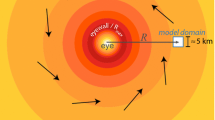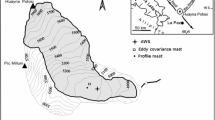Abstract
The Hong Kong Observatory conducted six flights in the atmospheric boundary layer of five tropical cyclones: tropical storm Jebi (1309), typhoon Kalmaegi (1415), severe tropical storm Linfa (1510), typhoon Mujigae (1522), and severe typhoon Nida (1604). Three-dimensional wind data with a 20-Hz sampling rate are available for a height range of 500–670 m, with the mean wind speed from these low-level flights ranging from 10 to 62 m s−1. The turbulent momentum flux and turbulence kinetic energy (e) are measured using the eddy-correlation method, while horizontal scales of turbulent eddies, vertical eddy diffusivity (K), and the vertical turbulent mixing length scale are estimated indirectly. The dependence of the momentum flux, e, K, and the vertical mixing length on wind speed and height are compared with previous studies. Both the momentum flux and turbulent kinetic energy increase with the wind speed, although the rate of increase is smaller for higher wind speeds. It is also found that K increases with wind speed according to a power law up to 40 m s−1 before levelling off, while the vertical mixing length is nearly constant at 100 m. The results serve as a reference for evaluating and improving the turbulent parametrizion in tropical-cyclone models, while the observed large turbulent mixing near the top of the inflow layer of the eyewall region should not be neglected in numerical models.













Similar content being viewed by others
References
Beswick KM, Gallagher MW, Webb AR, Norton EG, Perry F (2008) Application of the Aventech AIMMS20AQ airborne probe for turbulence measurements during the Convective Storm Initiation Project. Atmos Chem Phys 8(17):5449–5463
Black PG, D’Asaro EA, Drennan WM, French JR, Niiler PP, Sanford TB, Terrill EJ, Walsh EJ, Zhang JA (2007) Air–sea exchange in hurricanes: synthesis of observations from the coupled boundary layer air–sea transfer experiment. Bull Am Meteorol Soc 88(3):357–374
Chan PW, Hon K, Foster S (2011) Wind data collected by a fixed-wing aircraft in the vicinity of a tropical cyclone over the south China coastal. Meteorol Z 20:313–321
Chan PW, Wong WK, Hon KK (2014) Weather observations by aircraft reconnaissance inside Severe Typhoon Utor. Weather 69(8):199–202
Charney JG, Eliassen A (1964) On the growth of the hurricane depression. J Atmos Sci 21(1):68–75
Coronel R, Sawada M, Iwasaki T (2016) Impacts of surface drag coefficient and planetary boundary layer schemes on the structure and energetics of Typhoon Megi (2010) during intensification. J Meteorol Soc Jpn Ser II 94(1):55–73
Di Z, Duan Q, Gong W, Wang C, Gan Y, Quan J, Li J, Miao C, Ye A, Tong C (2015) Assessing WRF model parameter sensitivity: a case study with 5 day summer precipitation forecasting in the Greater Beijing Area. Geophys Res Lett 42(2):579–587
Donelan MA (1990) Air–sea interaction. In: LeMehaute B, Hanes DM (eds) The Sea. Wiley, Hoboken, pp 239–292
Drennan WM, Zhang JA, French JR, McCormick C, Black PG (2007) Turbulent fluxes in the hurricane boundary layer. Part II: latent heat flux. J Atmos Sci 64(4):1103–1115
Etling D, Brown RA (1993) Roll vortices in the planetary boundary layer: a review. Boundary-Layer Meteorol 65(3):215–248
Fang J, Tang J, Wu R (2009) The effect of surface friction on the development of tropical cyclones. Adv Atmos Sci 26(6):1146–1156
Foken T, Wichura B (1996) Tools for quality assessment of surface-based flux measurements. Agric For Meteorol 78(1):83–105
Foster RC (2009) Boundary-layer similarity under an axisymmetric, gradient wind vortex. Boundary-Layer Meteorol 131(3):321–344
Foster S, Chan PW (2012) Improving the wind and temperature measurements of an airborne meteorological measuring system. J Zhejiang Univ Sci A 13(10):723–746
French JR, Drennan WM, Zhang JA, Black PG (2007) Turbulent fluxes in the hurricane boundary layer. Part I: momentum flux. J Atmos Sci 64(4):1089–1102
Gall R, Tuttle J, Hildebrand P (1998) Small-scale spiral bands observed in hurricanes Andrew, Hugo, and Erin. Mon Weather Rev 126(7):1749–1766
Gopalakrishnan SG, Marks F, Zhang JA, Zhang X, Bao J-W, Tallapragada V (2013) A study of the impacts of vertical diffusion on the structure and intensity of the tropical cyclones using the high-resolution HWRF system. J Atmos Sci 70(2):524–541
Hanna SR (1968) A method of estimating vertical eddy transport in the planetary boundary layer using characteristics of the vertical velocity spectrum. J Atmos Sci 25(6):1026–1033
Holt T, Raman S (1988) A review and comparative evaluation of multilevel boundary layer parameterizations for first-order and turbulent kinetic energy closure schemes. Rev Geophys 26(4):761–780
Kepert JD (2012) Choosing a boundary layer parameterization for tropical cyclone modeling. Mon Weather Rev 140(5):1427–1445
Kilroy G, Montgomery MT, Smith RK (2017) The role of boundary-layer friction on tropical cyclogenesis and subsequent intensification. Q J R Meteorol Soc 143(707):2524–2536
Li Q, Duan Y, Yu H, Fu G (2010) Finescale spiral rainbands modeled in a high-resolution simulation of Typhoon Rananim (2004). Adv Atmos Sci 27(3):685–704
Liu J, Zhang F, Pu Z (2017) Numerical simulation of the rapid intensification of Hurricane Katrina (2005): sensitivity to boundary layer parameterization schemes. Adv Atmos Sci 34(4):482–496
Ming J, Zhang JA (2018) Direct measurements of momentum flux and dissipative heating in the surface layer of tropical cyclones during landfalls. J Geophys Res Atmos 123(10):4926–4938
Morrison I, Businger S, Marks F, Dodge P, Businger JA (2005) An observational case for the prevalence of roll vortices in the Hurricane boundary layer. J Atmos Sci 62(8):2662–2673
Nieuwstadt FTM (1984) The turbulent structure of the stable, nocturnal boundary layer. J Atmos Sci 41(14):2202–2216
Ooyama K (1969) Numerical simulation of the life cycle of tropical cyclones. J Atmos Sci 26(1):3–40
Pendergrass AG, Willoughby HE (2009) Diabatically induced secondary flows in tropical cyclones. Part I: quasi-steady forcing. Mon Weather Rev 137(3):805–821
Powell MD, Vickery PJ, Reinhold TA (2003) Reduced drag coefficient for high wind speeds in tropical cyclones. Nature 422:279–283
Rai D, Pattnaik S (2018) Sensitivity of tropical cyclone intensity and structure to planetary boundary layer parameterization. Asia-Pac J Atmos Sci 54(3):473–488
Shapiro LJ, Willoughby HE (1982) The response of balanced hurricanes to local sources of heat and momentum. J Atmos Sci 39(2):378–394
Smith RK, Montgomery MT, Van Sang N (2009) Tropical cyclone spin-up revisited. Q J R Meteorol Soc 135(642):1321–1335
Smith RK, Zhang JA, Montgomery MT (2017) The dynamics of intensification in a Hurricane Weather Research and forecasting simulation of Hurricane Earl (2010). Q J R Meteorol Soc 143(702):293–308
Tang J, Zhang JA, Aberson SD, Marks FD, Lei X (2018) Multilevel tower observations of vertical eddy diffusivity and mixing length in the tropical cyclone boundary layer during landfalls. J Atmos Sci 75(9):3159–3168
Tennekes H (1973) The logarithmic wind profile. J Atmos Sci 30(2):234–238
Trauth MH (2015) Time-series analysis. Springer, Berlin
Wang Y (2001) An explicit simulation of tropical cyclones with a triply nested movable mesh primitive equation model: TCM3. Part I: model description and control experiment. Mon Weather Rev 129(6):1370–1394
Wong MLM, Chan JCL (2006) Tropical cyclone motion in response to land surface friction. J Atmos Sci 63(4):1324–1337
Zhang F, Pu Z (2017) Effects of vertical eddy diffusivity parameterization on the evolution of landfalling hurricanes. J Atmos Sci 74(6):1879–1905
Zhang F, Pu Z, Wang C (2017a) Effects of boundary layer vertical mixing on the evolution of hurricanes over land. Mon Weather Rev 145(6):2343–2361
Zhang JA, Black PG, French JR, Drennan WM (2008a) First direct measurements of enthalpy flux in the hurricane boundary layer: the CBLAST results. Geophys Res Lett. https://doi.org/10.1029/2008GL034374
Zhang JA, Drennan WM (2012) An observational study of vertical eddy diffusivity in the hurricane boundary layer. J Atmos Sci 69(11):3223–3236
Zhang JA, Drennan WM, Black PG, French JR (2009) Turbulence structure of the hurricane boundary layer between the outer rainbands. J Atmos Sci 66(8):2455–2467
Zhang JA, Katsaros KB, Black PG, Lehner S, French JR, Drennan WM (2008b) Effects of roll vortices on turbulent fluxes in the hurricane boundary layer. Boundary-Layer Meteorol 128(2):173–189
Zhang JA, Marks FD, Montgomery MT, Lorsolo S (2011a) An estimation of turbulent characteristics in the low-level region of intense Hurricanes Allen (1980) and Hugo (1989). Mon Weather Rev 139(5):1447–1462
Zhang JA, Marks FD, Sippel JA, Rogers RF, Zhang X, Gopalakrishnan SG, Zhang Z, Tallapragada V (2018) Evaluating the impact of improvement in the horizontal diffusion parameterization on hurricane prediction in the operational Hurricane Weather Research and Forecast (HWRF) model. Weather Forecast 33(1):317–329
Zhang JA, Rogers RF, Nolan DS, Marks FD Jr. (2011b) On the characteristic height scales of the hurricane boundary layer. Mon Weather Rev 139(8):2523–2535
Zhang JA, Rogers RF, Tallapragada V (2017b) Impact of parameterized boundary layer structure on tropical cyclone rapid intensification forecasts in HWRF. Mon Weather Rev 145(4):1413–1426
Zhao ZK, Liu CX, Li Q, Dai GF, Song QT, Lv WH (2015) Typhoon air–sea drag coefficient in coastal regions. J Geophys Res: Oceans 120(2):716–727
Zhu P, Furst J (2013) On the parameterization of surface momentum transport via drag coefficient in low-wind conditions. Geophys Res Lett 40(11):2824–2828
Zhu P, Menelaou K, Zhu Z (2014) Impact of subgrid-scale vertical turbulent mixing on eyewall asymmetric structures and mesovortices of hurricanes. Q J R Meteorol Soc 140(679):416–438
Zhu P, Wang Y, Chen SS, Curcic M, Gao C (2015) Impact of storm-induced cooling of sea surface temperature on large turbulent eddies and vertical turbulent transport in the atmospheric boundary layer of Hurricane Isaac. J Geophys Res: Oceans 121(1):861–876
Acknowledgements
We are grateful to the scientists and crew members who participated in the field work that helped collect the aircraft data used in this study. Zhongkuo Zhao was sponsored by the National Major Fundamental Research Program of China (Grant No. 2018YFC1507401) and the National Natural Science Foundation (Grant Nos. 41875021, 41830533, 41675019, 41675021). Jun Zhang was supported by Grant NA14NWS4680028 and NSF Grants AGS1822128 and ASG1654831.
Author information
Authors and Affiliations
Corresponding author
Additional information
Publisher's Note
Springer Nature remains neutral with regard to jurisdictional claims in published maps and institutional affiliations.
Electronic supplementary material
Below is the link to the electronic supplementary material.
Rights and permissions
About this article
Cite this article
Zhao, Z., Chan, P.W., Wu, N. et al. Aircraft Observations of Turbulence Characteristics in the Tropical Cyclone Boundary Layer. Boundary-Layer Meteorol 174, 493–511 (2020). https://doi.org/10.1007/s10546-019-00487-8
Received:
Accepted:
Published:
Issue Date:
DOI: https://doi.org/10.1007/s10546-019-00487-8




